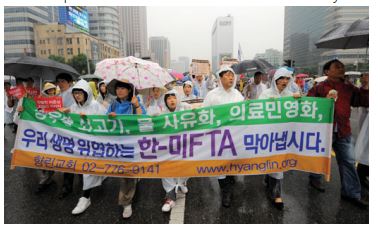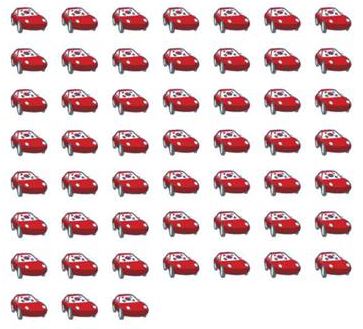Case Study:
Why do nations trade? Presumably, each trading partner has something to gain, such as access to more goods and services and lower prices. For example, the money that consumers save by buying low-cost food imports can be spent on other products, resulting in a higher standard of living. Open markets are one way that globalization has led to economic integration. In 2007, the United States and South Korea completed preliminary negotiations to establish the world’s largest bilateral trade agreement. The proposed deal would reduce tariffs on about 90 percent of product categories; prior to the agreement, South Korea’s tariffs on imported food averaged about 52 percent. Overall, its import tariffs averaged about 11.2 percent. By comparison, the United States has a 12 percent tariff on food and overall tariffs of about 3.7 percent. Observers expected that a reduction in South Korea’s tariffs would boost exports from the United States by $11 billion each year; exports totaled about $50 billion in 2008. General Motors, Ford, and Chrysler are some of the U.S. companies that stand to benefit from improved access to a market with 48 million people. Each year, only about 5,000 American cars are sold in South Korea, compared with 800,000 Korean cars sold in the United States. In fact, the trade gap in autos accounts for about 80 percent of South Korea’s trade deficit with the United States, which stood at $13 billion in 2006. American farmers and ranchers also anticipate increased demand for beef and other agricultural exports as import tariffs of 40 percent are phased out over 15 years. For its part, the United States agreed to reduce tariffs on automobile and electronics imports; this will be a boon for Hyundai, Samsung, LG, and other industry leaders in South Korea. On paper, it appears that both sides will benefit from KORUS, as the free trade agreement has been called. If that is true, why are some people and organizations adamantly opposed to the agreement? Trade deals require all parties to make concessions, and the negotiations between the United States and South Korea are a case in point. American beef exports plunged after an outbreak of BSE (mad-cow disease) in 2003. Before the mad cow scare, the Asian nation was the third-largest market for U.S. beef exports. In the spring of 2008, a few weeks after taking office, President Lee Myung-bak decided to lift a ban on U.S. beef; in return, the United States agreed to exclude South Korea’s rice industry from the trade agreement. Why? Rice represents about half of South Korea’s agricultural output; a high import tariff means that local rice farmers can charge much higher prices for their crops than farmers in other rice-producing nations such as China. Even though they pay up to three times more for rice than consumers in other Asian countries, many Koreans sympathize with the farmers’ concerns; domestic rice production is a source of pride and a symbol of self-sufficiency. As one activist noted, “It is a right for a country to feed its own people and a right for a country to produce its own food.” After President Lee’s decision was made public, news reports suggested that mad cow disease could still be present in U.S. herds. Opposition politicians from the United Democratic Party, whose candidate was defeated in the most recent presidential election, took advantage of the negative publicity to suggest that Mr. Lee had caved in to demands by American trade negotiators. The rumors fueled a backlash that included rumors that American consumers don’t eat the type of beef that is exported and that consumer products such as mascara contain beef by-products and could be tainted. In May 2008, thousands of people gathered in Seoul to protest. For U.S. President George W. Bush, the trade pact with South Korea was an important political victory. Suspicion and doubt about trade and globalization was growing among Congressional Democrats. Proposed trade pacts with Colombia and Panama had been given a cool reception. Although the accord with South Korea was concluded in April 2007, it still had to be ratified by lawmakers in both countries. In 2009, a South Korean parliamentary committee approved the FTA; however, it was not presented to the General Assembly for a full vote. Meanwhile, amid ongoing concerns about remaining export barriers for beef and autos, the U.S. Congress did not ratify the agreement either. Ford, Chrysler, and the United Auto Workers union opposed the deal. Hyundai and Kia, the stars of Korea’s auto industry, were enjoying great success in the United States despite the recession. Overall sales of both foreign and domestic cars were down by nearly 40 percent in the U.S. market. By contrast, sales for Hyundai and Kia were only down 3.6 percent. When U.S. President Barack Obama traveled to Toronto for the G-20 conference in 2010, he met with President Lee. The relationship between the two allies had taken on a new significance after North Korean forces allegedly attacked and sank a South Korean naval vessel. Forty-six sailors died in the attack. At the Toronto summit, President Obama expressed solidarity with South Korea and promised to urge the U.S. Congress to ratify the FTA. South Korea hosted a G-20 conference in November 2010, and it was widely expected that a final announcement would be made at that time. However, it was not to be: President Obama and President Lee came away from the summit empty-handed. However, one month later, Washington and Seoul completed the negotiations and the agreement was signed. The break though came in part because the deal extended a 2.5 percent tariff on Korean cars and a 25 percent tariff on Korean SUVs for several years. An earlier


version of the treaty would have lifted those tariffs immediately. For its part, Korea agreed to immediately drop its tariff on U.S. car imports from 8 percent to 4 percent. As a result of the changes, the United Auto Workers union threw its support behind the agreement. Calling it a “landmark trade deal,” President Obama urged Congress to ratify the FTA before the August 2011 recess. The agreement was also subject to approval by South Korea’s National Assembly. Meanwhile, South Korea finalized a trade agreement with the European Union. Implemented in 2011, it surpasses KORUS as the world’s largest. Currently, two-way trade is worth about $100 billion each year; South Korea enjoys a trade surplus with the EU of nearly $20 billion. Agriculture was not a key issue in the negotiations; however, regulations that protect Korea’s auto industry needed to be addressed. Because South Korea’s automakers specialize in small cars, Seoul wants to phase out tariffs on small cars more gradually than tariffs on large vehicles. For its part, the EU wants more stringent rules of origin so that, for example, South Korean exports assembled from Chinese-made components would be excluded. In 2011, voices on both sides of the issue continued to be heard. Among the supporters were two members of former President Bill Clinton’s staff. Writing in The Wall Street Journal, Thomas McLarty III and Nelson Cunningham identified four conditions that would have to be met in order for the Korea pact to be ratified in Congress. First, passage would require strong presidential leadership, and President Obama must be fully committed. Second, the White House staff and cabinet would have to be unified in pulling for passage. Third, the effort must be truly bipartisan. Finally, McLarty and Cunningham urged President Obama to show that his commitment to free trade extends beyond the U.S.-Korea FTA and includes pending agreements with Colombia and Panama.
Q1. When a trade deal is passed, there are winners and losers. Who stands to win if Congress ratifies the U.S.–Korea free trade agreement? Who stands to lose?
Q2. In the United States, the United Auto Workers supported the Korea trade deal, but the machinists union did not. How do you explain this split in the U.S. labor movement?
Q3. Why is the global automobile industry often at the center of disagreements over trade relations?
Q4. As this book went to press, the U.S. Congress had not ratified the FTA with Korea. What is the update? Has the deal been ratified or not? Which of the requirements identified in the final paragraph of the case study affected the outcome?
Your answer must be, typed, double-spaced, Times New Roman font (size 12), one-inch margins on all sides, APA format and also include references.